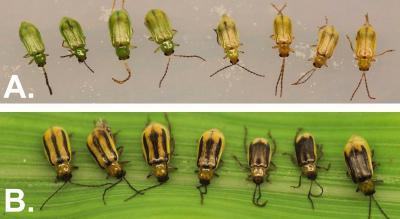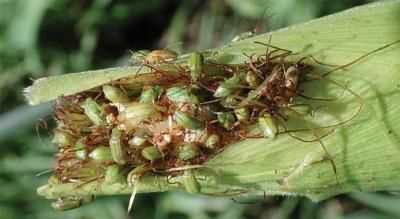Corn rootworms adults are emerging in South Dakota (Figure 1). The adults of both the northern and western corn rootworms generally emerge in early to mid-July and remain active until the first hard frost. The emergence of these primarily underground corn pests can provide some insight into field population levels and what the potential for future root injury might be.
Identification

Figure 1. A) Northern corn rootworm and B) western corn rootworm adults. Courtesy: Adam Varenhorst.
The larvae of both corn rootworm species are small and white in color. The larvae will only be observed in the soil. With emergence underway, there probably aren’t many to find at this time.
The adult northern corn rootworms are green in color (Figure 1-A). However, sometimes northern corn rootworm adults are a yellow color shortly after they emerge. They will develop the green color as they begin feeding.
Western corn rootworms are yellow in color with three incomplete black stripes on their abdomens (Figure 1-B). Sometimes these stripes can bleed together. The stripes never reach the end of the abdomen.
Scouting

Figure 2. Northern corn rootworms adults feeding on corn silks. Courtesy: Marlin E. Rice.
The adult rootworm populations can be monitored by using yellow sticky cards. The sticky cards should be placed in several locations in the fields during July and scouted and replaced weekly through August. If the average captures from a field exceed two rootworm adults (of either species) per-trap, per-day for a week, the economic threshold has been exceeded. At this point, future management of the rootworms is advised for the next time corn is planted into the field. If a management strategy was already in place, this would suggest that something different would need to be used.
Another scouting method for larval activity is to dig corn roots and evaluate the amount of feeding injury present on the roots at nodes four, five and six. If the roots are clipped to within 1 ½ inches of the stalk, it is considered injured. The amount of injury observed on each node is added together and evaluated on a 0–3 nodal injury scale. A rating of one on the scale is associated with 15–17% yield loss.
Adult corn rootworms are typically not an issue for corn. However, they can cause issues if large populations begin to clip silks during pollination (Figure 2). Sampling for silk clipping should begin right around the onset of the silking stage.
The best time to scout for corn rootworm adults is from midmorning to late afternoon. If corn rootworm adults are observed in a field, scout five random plants from 10 different locations throughout the field. The number of corn rootworm adults present should be recorded. The threshold for corn rootworm adults on corn plants is an average of five or more beetles per plant during the first week or so of pollen shed. If the threshold is reached, a foliar insecticide is recommended to reduce the populations.
Another way to monitor for corn rootworm adult activity in a corn field is to monitor for silk clipping. During pollen shed, scout five random plants from 10 different locations throughout the field. For each plant, measure the length of the remaining silk that is protruding from the ear of the selected plant. If the silks are clipped to within ½ inch of the ear tip on 25–50% of the total number of scouted plants, foliar insecticide application is recommended. It is important to remember that yield will not be affected if silk is clipped after pollination has occurred (brown silks present). It’s also important to remember that there are also other insects that may be responsible for clipping the silks.
Source :